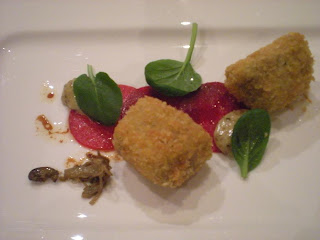
 dessert sample
dessert sample Pan sear wagyu with spring vege and burgundy glaze.
Pan sear wagyu with spring vege and burgundy glaze. Medallion of Chicken, cepe mushroom with cappuccino of parley and demi-glace
Medallion of Chicken, cepe mushroom with cappuccino of parley and demi-glace Sweet bread, cepe mushroom and beet
Sweet bread, cepe mushroom and beet Pan Fried Foir Gras with caramelised onions and port reductions
Pan Fried Foir Gras with caramelised onions and port reductions
warm fruit salad serve with crispy rice crackers
 Various steam rice "custard" serve with crispy pork skin and dried shrimp, side with a tangy fish sauce.
Various steam rice "custard" serve with crispy pork skin and dried shrimp, side with a tangy fish sauce.This is the Chicken version
 "Pho" Bu or Beef Noodle soap. like the raw herb and vege. the chili is fierce hot!
"Pho" Bu or Beef Noodle soap. like the raw herb and vege. the chili is fierce hot!with happy Chris Low at the back ground.

Chris Low: Ho Chi Minh City, Vietnam was a mystery country to me until June this year. Way before i step into this country, all i know about this communist country is from movie like "Good Morning Vietnam" and American TV series " Tour of Duty, Vietnam".
Until i visited the War Museum in HCMC, my view about the image of Vietnam totally changed and i wanted to know more about this country. And as what Cork Brothers always do, we discover the Vietnamese culture true the basic needs: Food!
Lionel and me visited HCMC in early June for 2 days. And i return to visit our business partner Mr.Thien in August with a bang...more wine and food encounters!
We were introduce to Southern Vietnamese food which includes various Spring rolls serve raw or deep fried. Fresh seafood from the river like fresh water prawns braised in thick soy and fish sauce; snails blanched and chopped with pork then braised with light broth; and "Pho"
Ultimately, the based is rice made product, fish sauce, fish sauce and better fish sauce + lots of healthy "unknown to me" raw salads, basils, bean sprouts and vegetables.
But what i like is "Huei" cuisine from the middle Vietnam. Slightly more intense from the Saigon styles. I need more visit to talk about this type of cooking. At this stage, all i can says is: "Unique and delicious!"
Street food to fine dining restaurant's...HCMC has lots to offer. And so wine friendly!
Will definitely sample more!






